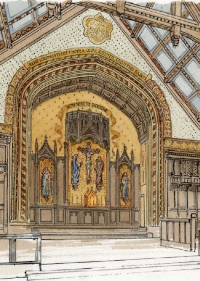- Home
-
About
 Fidelity & Excellence
Fidelity & ExcellenceThomas Aquinas College is unique among American colleges and universities, offering a faithfully Catholic education comprised entirely of the Great Books and classroom discussions.
-
A Liberating Education
 Truth Matters
Truth MattersTruth, and nothing less, sets men free; and because truth is both natural and supernatural, the College’s curriculum aims at both natural and divine wisdom.
-
A Catholic Life
 Under the Light of Faith
Under the Light of FaithThe intellectual tradition and moral teachings of the Catholic Church infuse the whole life of Thomas Aquinas College, illuminating the curriculum and the community alike.
-
Admission & Aid
 Is TAC Right for You?
Is TAC Right for You?Do you enjoy grappling with complex questions? Are you willing to engage in discussions about difficult concepts, with the truth as your ultimate goal?
-
Students & Parents
 Mind, Body & Spirit
Mind, Body & SpiritThere is always something to do at TAC — something worthwhile, something fulfilling, and something geared toward ever-greater spiritual and intellectual growth.
-
Alumni & Careers
 What Can You Do with a Liberal Education?
What Can You Do with a Liberal Education?Nothing speaks more to the versatility of the College’s academic program than the good that our alumni are doing throughout the Church and the world.
- Search
- Giving
Work Begins on New England Sanctuary, with a Link to TAC’s California Past
Years before Thomas Aquinas College came to New England, its then president, Dr. Thomas E. Dillon was overseeing the construction of Our Lady of the Most Holy Trinity Chapel on the California campus. At the same time, Rev. Greg Markey, who now serves as chaplain on the New England campus, was engaged with a similar project: “I was a pastor in Connecticut, reconstructing a church there,” he recalls. “And we were using the same architect that Dr. Dillon was using in California. I only knew Thomas Aquinas College remotely.”
The architect, Duncan Stroik, could see the striking similarity of the visions of the College president and determined clergyman — and put the two men in touch with one another. “I actually talked to Dr. Dillon,” Fr. Markey relates, “just months before he died in the car accident, on the phone … about his vision for the chapel in California.” Little did Dr. Dillon know that this same pastor from the eastern seaboard would one day work to overhaul a second chapel for the College in New England.
Dr. Dillon’s structure is “one of the masterpieces in architecture of the last 50 or 100 years in this country. It’s tremendous,” the New England chaplain remarks. “Now we have this great edifice here that’s impressive in its own right, and we’re trying to do something similar. … We’re communicating the idea that, as Dr. Dillon would have said, this building is the most important building on our campus, and we want it to look appropriate.”
For the next week, except for during Masses, the current altar will be removed from the sanctuary to make way for the reredos and altar of repose, both of which should be in place by Friday evening. Soon to be the focal point of the building, the ornate backdrop will contain a large crucifix at its center, flanked by carvings of the Blessed Mother and St. John the Beloved. On either side of this Crucifixion scene will stand St. Thomas Aquinas, the venerable patron of the College, and St. John Henry Newman, a champion of the Catholic faith and liberal education.
Soon after, at the beginning of February, Canning Ecclesiastical painters will arrive on campus. After a week constructing their scaffolding, the artists will spend two to three months painting the sanctuary. “Please God,” Fr. Markey says, “by May, at the end of the semester, we’re going to have a completely finished sanctuary: sacristies that will be functioning, altars that are functioning, and everything up and running. And it will look fantastic.”
“It will definitely change both the way I offer the Mass and the way we pray, because beauty is a very important part of Catholic liturgy,” the chaplain concludes. “The Catholic Church has always been a patron of the arts, and always tried to integrate beauty within the liturgy. We’re not puritanical in our approach to this. We are incarnational as a Church. So we need beauty, and high-quality beauty.”


